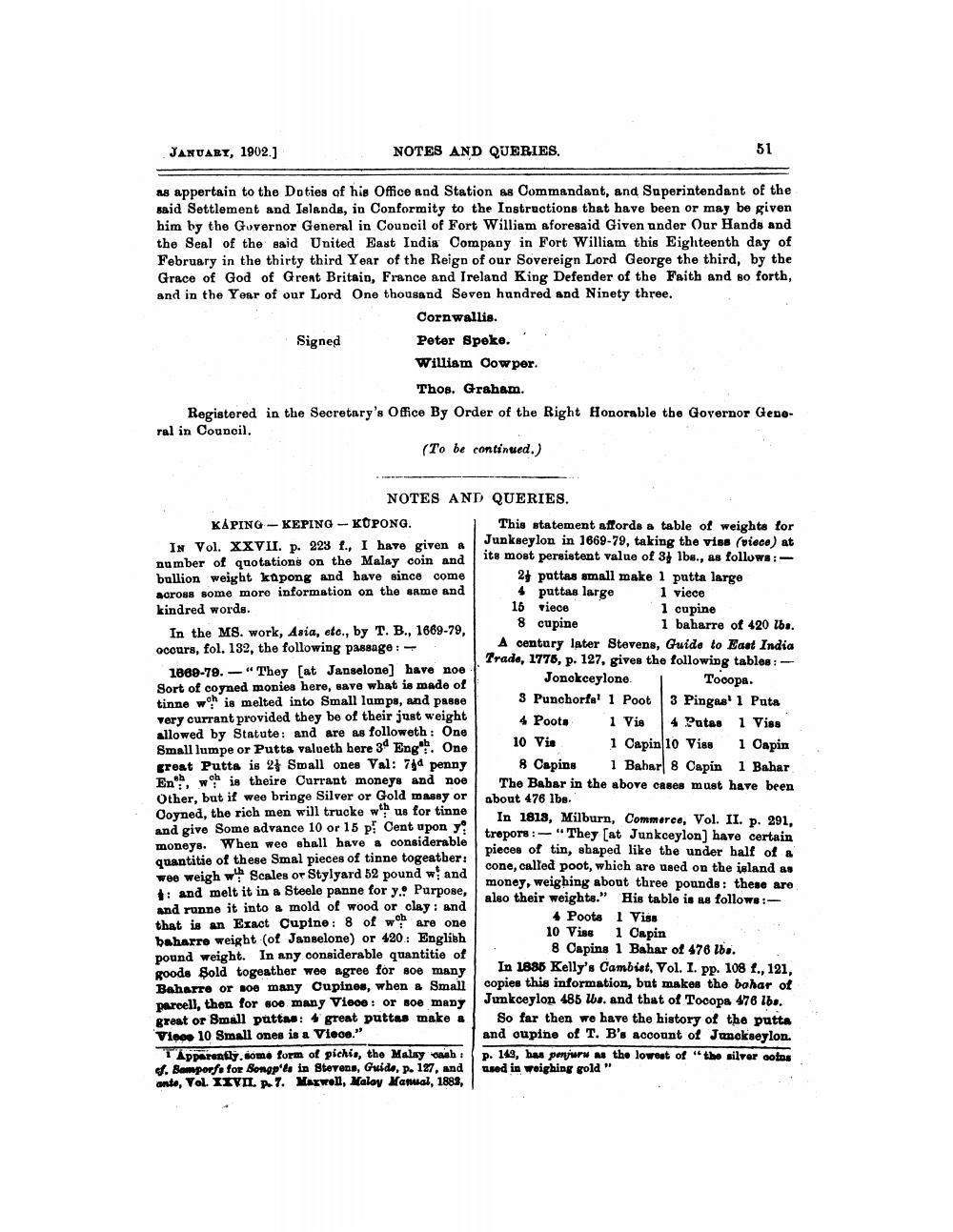________________
JANUARY, 1902.]
NOTES AND QUERIES.
as appertain to the Duties of his Office and Station as Commandant, and Superintendant of the said Settlement and Islands, in Conformity to the Instructions that have been or may be given him by the Governor General in Council of Fort William aforesaid Given under Our Hands and the Seal of the said United East India Company in Fort William this Eighteenth day of February in the thirty third Year of the Reign of our Sovereign Lord George the third, by the Grace of God of Great Britain, France and Ireland King Defender of the Faith and so forth, and in the Year of our Lord One thousand Seven hundred and Ninety three.
Cornwallis. Peter Speke. William Cowper.
Thos. Graham.
Registered in the Secretary's Office By Order of the Right Honorable the Governor General in Council.
(To be continued.)
Signed
NOTES AND QUERIES.
KAPING
KEPING-KUPONG.
IN Vol. XXVII. p. 223 f., I have given a number of quotations on the Malay coin and bullion weight kapong and have since come across some more information on the same and kindred words.
In the MS. work, Asia, etc., by T. B., 1669-79, occurs, fol. 132, the following passage: -
-
1869-79. "They [at Janselone] have noe Sort of coyned monies here, save what is made of tinne w is melted into Small lumps, and passe very currant provided they be of their just weight allowed by Statute: and are as followeth: One Small lumpe or Putta valueth here 3 Eng. One great Putta is 2 Small ones Val: 74d penny En, w is theire Currant moneys and noe Other, but if wee bringe Silver or Gold massy or Coyned, the rich men will trucke wh us for tinne and give some advance 10 or 15 p! Cent upon y moneys. When wee shall have a considerable quantitie of these Smal pieces of tinne togeather: wee weigh w Scales or Stylyard 52 pound w and
ch
and melt it in a Steele panne for y. Purpose, and runne it into a mold of wood or clay: and that is an Exact Cupine: 8 of wh are one baharre weight (of Janselone) or 420: English pound weight. In any considerable quantitie of goods Sold togeather wee agree for soe many Baharre or soe many Cupines, when a Small parcell, then for soe many Viece: or soe many great or Small puttas: 4 great puttas make a Viece 10 Small ones is a Viece."
Apparently, some form of pichis, the Malay cash: ef. Bamporfs for Songp'és in Stevens, Guide, p. 127, and ante, Vol. XXVII. p. 7. Maxwell, Malay Manual, 1888,
51
This statement affords a table of weights for Junkseylon in 1669-79, taking the viss (viece) at its most persistent value of 3 lbs., as follows:2 pattas small make 1 putta large 4 puttas large
1 viece
15 viece 8 cupine
1 cupine
1 baharre of 420 lbs.
A century later Stevens, Guide to East India Trade, 1775, p. 127, gives the following tables: - Jonckceylone. Tocopa. 3 Punchorfa 1 Poot 3 Pingas' 1 Puta 4 Poots
1 Vis 4 Putas 1 Viss
10 Vis
1 Capin 10 Viss 1 Capin 8 Capins 1 Bahar 8 Capin 1 Bahar. The Bahar in the above cases must have been about 476 lbs.
In 1818, Milburn, Commerce, Vol. II. p. 291, trepors:-"They [at Junkceylon] have certain pieces of tin, shaped like the under half of a cone, called poot, which are used on the island as also their weights." His table is as follows:money, weighing about three pounds: these are
4 Poots I Viss
10 Viss 1 Capin
8 Capins 1 Bahar of 476 lbs.
In 1885 Kelly's Cambist, Vol. I. pp. 108 f., 121, copies this information, but makes the bahar of Junkceylon 485 lbs. and that of Tocopa 476 lbs.
So far then we have the history of the putta and cupine of T. B's account of Junekseylon. p. 143, has penjuru as the lowest of "the silver coins used in weighing gold "




